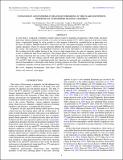Files in this item
Ultraviolet and extreme-ultraviolet emissions at the flare footpoints observed by atmosphere imaging assembly
Item metadata
| dc.contributor.author | Qiu, J. | |
| dc.contributor.author | Sturrock, Z. | |
| dc.contributor.author | Longcope, D.W. | |
| dc.contributor.author | Klimchuk, J.A. | |
| dc.contributor.author | Liu, W.-J. | |
| dc.date.accessioned | 2014-09-25T12:01:06Z | |
| dc.date.available | 2014-09-25T12:01:06Z | |
| dc.date.issued | 2013-09-01 | |
| dc.identifier | 151132856 | |
| dc.identifier | d70caf0e-7c93-4a88-9724-cbf6f54eebc9 | |
| dc.identifier | 84882991661 | |
| dc.identifier.citation | Qiu , J , Sturrock , Z , Longcope , D W , Klimchuk , J A & Liu , W-J 2013 , ' Ultraviolet and extreme-ultraviolet emissions at the flare footpoints observed by atmosphere imaging assembly ' , Astrophysical Journal , vol. 774 , no. 1 , 14 . https://doi.org/10.1088/0004-637X/774/1/14 | en |
| dc.identifier.issn | 0004-637X | |
| dc.identifier.uri | https://hdl.handle.net/10023/5499 | |
| dc.description.abstract | A solar flare is composed of impulsive energy release events by magnetic reconnection, which forms and heats flare loops. Recent studies have revealed a two-phase evolution pattern of UV 1600 Å emission at the feet of these loops: a rapid pulse lasting for a few seconds to a few minutes, followed by a gradual decay on timescales of a few tens of minutes. Multiple band EUV observations by the Atmosphere Imaging Assembly further reveal very similar signatures. These two phases represent different but related signatures of an impulsive energy release in the corona. The rapid pulse is an immediate response of the lower atmosphere to an intense thermal conduction flux resulting from the sudden heating of the corona to high temperatures (we rule out energetic particles due to a lack of significant hard X-ray emission). The gradual phase is associated with the cooling of hot plasma that has been evaporated into the corona. The observed footpoint emission is again powered by thermal conduction (and enthalpy), but now during a period when approximate steady-state conditions are established in the loop. UV and EUV light curves of individual pixels may therefore be separated into contributions from two distinct physical mechanisms to shed light on the nature of energy transport in a flare. We demonstrate this technique using coordinated, spatially resolved observations of UV and EUV emissions from the footpoints of a C3.2 thermal flare. | |
| dc.format.extent | 10 | |
| dc.format.extent | 1130558 | |
| dc.language.iso | eng | |
| dc.relation.ispartof | Astrophysical Journal | en |
| dc.subject | Magnetic reconnection | en |
| dc.subject | Sun: flares | en |
| dc.subject | Sun: UV radiation | en |
| dc.subject | QB Astronomy | en |
| dc.subject | QC Physics | en |
| dc.subject.lcc | QB | en |
| dc.subject.lcc | QC | en |
| dc.title | Ultraviolet and extreme-ultraviolet emissions at the flare footpoints observed by atmosphere imaging assembly | en |
| dc.type | Journal article | en |
| dc.contributor.institution | University of St Andrews. Applied Mathematics | en |
| dc.identifier.doi | 10.1088/0004-637X/774/1/14 | |
| dc.description.status | Peer reviewed | en |
This item appears in the following Collection(s)
Items in the St Andrews Research Repository are protected by copyright, with all rights reserved, unless otherwise indicated.

